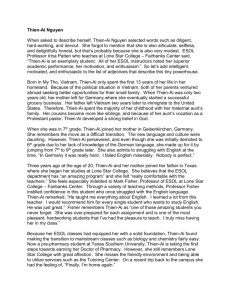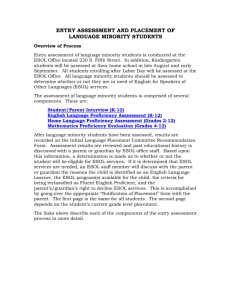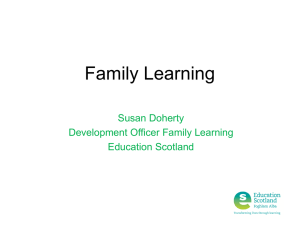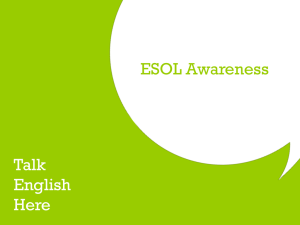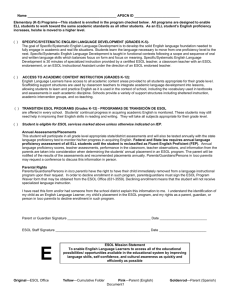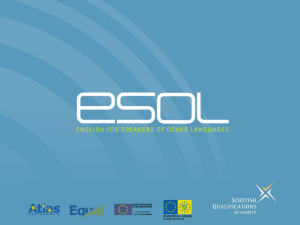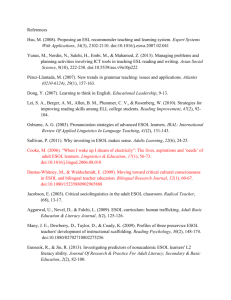Information about our ESOL Department
advertisement
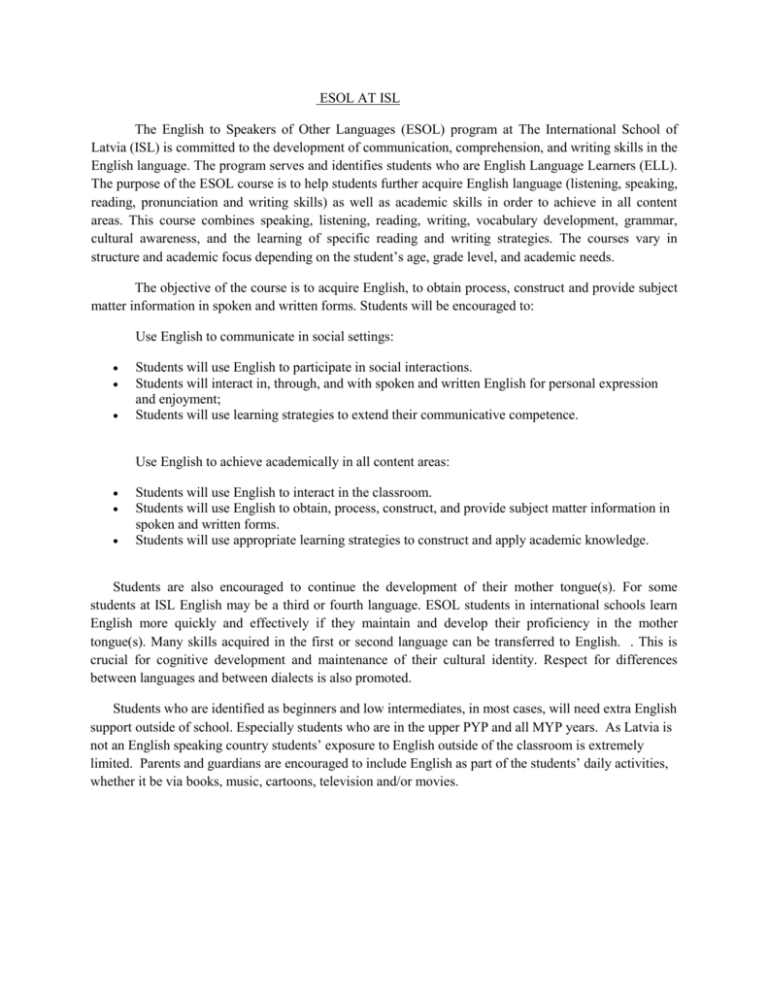
ESOL AT ISL The English to Speakers of Other Languages (ESOL) program at The International School of Latvia (ISL) is committed to the development of communication, comprehension, and writing skills in the English language. The program serves and identifies students who are English Language Learners (ELL). The purpose of the ESOL course is to help students further acquire English language (listening, speaking, reading, pronunciation and writing skills) as well as academic skills in order to achieve in all content areas. This course combines speaking, listening, reading, writing, vocabulary development, grammar, cultural awareness, and the learning of specific reading and writing strategies. The courses vary in structure and academic focus depending on the student’s age, grade level, and academic needs. The objective of the course is to acquire English, to obtain process, construct and provide subject matter information in spoken and written forms. Students will be encouraged to: Use English to communicate in social settings: Students will use English to participate in social interactions. Students will interact in, through, and with spoken and written English for personal expression and enjoyment; Students will use learning strategies to extend their communicative competence. Use English to achieve academically in all content areas: Students will use English to interact in the classroom. Students will use English to obtain, process, construct, and provide subject matter information in spoken and written forms. Students will use appropriate learning strategies to construct and apply academic knowledge. Students are also encouraged to continue the development of their mother tongue(s). For some students at ISL English may be a third or fourth language. ESOL students in international schools learn English more quickly and effectively if they maintain and develop their proficiency in the mother tongue(s). Many skills acquired in the first or second language can be transferred to English. . This is crucial for cognitive development and maintenance of their cultural identity. Respect for differences between languages and between dialects is also promoted. Students who are identified as beginners and low intermediates, in most cases, will need extra English support outside of school. Especially students who are in the upper PYP and all MYP years. As Latvia is not an English speaking country students’ exposure to English outside of the classroom is extremely limited. Parents and guardians are encouraged to include English as part of the students’ daily activities, whether it be via books, music, cartoons, television and/or movies. The aims and objectives of the ESOL course are: Students will understand that reading and writing are a process. Students will read for pleasure and information with increasing independence. They will read for meaning using a variety of reading skills. They will be confident about their own reading and will continue to develop a range of reading strategies to decode and make sense of text. They will acquire vocabulary necessary to discuss stories heard and read, demonstrate awareness of the role of the characters and plot, and they will respond to the ideas and feelings expressed. They will begin to use a variety of reference books and dictionaries independently and in small groups. Students will write confidently, with developing legibility and fluency. They will write for a variety of purposes and will develop an understanding of different story structures. They will begin to plan, edit and review their own writing, showing an increasing ability to spell high-frequency words. They will begin to use spelling patterns and will continue to use their phonetic skills to spell, especially when constructing more complex words. As risk-takers, they will demonstrate confidence in attempting to write unfamiliar words using a variety of strategies. Students will learn to: read and write for enjoyment, instruction and information; recognise and appreciate the variety of literary styles, genres and structures such as poetry, plays and stories, creative, informative, instructional, persuasive and reflective text; understand and apply a variety of structures, strategies and literary techniques (spelling, vocabulary, sentence structure, grammar, prediction, plot, character, punctuation, voice). In the area of oral communication, students will learn to: listen and respond to a range of texts, and to the ideas and opinions of others; improve fluency and accuracy when speaking; ask and answer questions; relate and retell; persuade; talk about needs, feelings, ideas and opinions; contribute to discussions in a range of formal and informal situations; recognise that oral language needs to be appropriate to the audience and to the purpose. IDENTIFICATION PROCESS FOR ESOL STUDENTS AT ISL For new students: If English is not spoken at home, or if the new student had limited instruction in English at their previous school, or if the student had not been exited from the ESOL programme in their previous International school, the student will join the ESOL course during Language Block instead of French or German. They will be given the LAS (Language Assessment System) Placement test to determine their level of proficiency. For ISL students: A teacher has concerns that a student's proficiency level is hindering learning: The Teacher meets with the ESOL Teacher (with the student’s writing samples and observations notes) ↓ The ESOL teacher gives the student the LAS Placement test ESOL AT ISL: EXIT CRITERIA (Only takes place at the beginning or end of the academic year, students will not be exited mid- year) Student progress in the expository and receptive areas is documented and reported through observation notes, assessments, work samples, report writing, parent/teacher conferences, student/teacher conferences, ESOL teacher/English teacher conferences. ↓ If the student is consistently producing work at the ‘proficient’ level (see attached benchmarks), the ESOL teacher will meet with the student’s teacher. If the teachers confirm progress, ↓ The student will be given the LAS (Language Assessment System) If the result is at the ‘Above Proficient’ level, the student may exit ESOL and join French or German the next academic year. ↓ A letter will be sent to parents informing them that the student has fulfilled the ESOL exiting criteria and may start German or French the next academic year. ESOL EXITING BENCHMARKS1 Linguistic ESOL Exit Benchmarks for Kindergarten LISTENING: The student… follows simple directions recalls details in an oral story makes simple inferences SPEAKING: The student… produces simple sentences with errors that do not interfere with communication. produces accurate labels for less-common objects in social situations uses appropriate words and phrases when describing school-related processes can tell a simple story with mostly correct vocabulary and simple grammar READING: The student… discriminates between beginning and ending sounds identifies frequently used rhyming words match words to definitions or descriptions recall events in a story in a passage read aloud read simple sentences independently WRITING: The student… uses correct grammar such as singular nouns, subject pronouns, subject/verb agreement capitalizes beginning of a sentence writes a complete sentence with few errors that describes a picture. Linguistic ESOL Exit Benchmarks for Grade 1 LISTENING: The student… • • • recalls stated details in an oral story can make simple inferences follows simple oral directions by distinguishing the location of an object in relation to another object SPEAKING: The student… • • • • produces simple sentences with errors that do not interfere with communication when making requests and conduction business in the classroom Produces accurate labels for less-common objects in social situations Uses accurate vocabulary to describe the purpose of less-common objects in social situations can tell a simple story with mostly correct vocabulary and simple grammar READING: The student… discriminates between beginning and ending sounds identifies less- frequently used rhyming words match words to definitions or descriptions recall events in a story in a passage read aloud read simple sentences independently WRITING: The student… • • • uses correct grammar such as singular nouns, subject pronouns, subject/verb agreement, modal auxiliary verb construction, and future tense uses capital letters at the beginning of a sentences as well as appropriate sentences ending marks writes complete sentence to describe a picture or preference; communication is clear and complete, though minor errors may occur. Linguistic ESOL Exit Benchmarks for Grade 2-3 LISTENING: The student… • • • follows more complex directions recalls subtle details in an oral story determines main idea of an oral story SPEAKING: The student… • produces sentences with more sophisticated vocabulary with minor errors in grammar when providing information, describing social situation, describing a multi-step process, or explaining reasoning READING: The student… • • • • • • • • identifies rhyming words written with diphthongs identifies short and long vowel sounds and less-frequent ending sounds identifies synonyms of social and academic vocabulary uses context clues to determine a word’s meaning recalls implicit details describes a character makes inferences with strong context support transfers concepts learned to a new situation WRITING: The student… • • • uses verb tense agreement and appropriate indefinite articles with minor errors uses punctuation in dates writes fluently to describe a picture or to explain a preference; communication is clear and complete, though it may contain minor errors Linguistic ESOL Exit Benchmarks for Grade 4-5 LISTENING: The student… • • • • follows multi-step directions using academic vocabulary recalls stated details in a classroom discussion and a class lesson identifies sequences of steps determines main idea of a class lesson SPEAKING: The student… • • • produces sentences with more sophisticated vocabulary with minor errors in grammar when providing information, describing social situation, asking questions, and expressing an opinion. Uses complex sentence structure and accurate vocabulary when describing location and directions, with minor error. Minor errors do not interfere with communication in academic situations READING: The student…. • • • • • • Divides words into syllables Uses knowledge lower-frequency prefixes and suffixes Identifies synonyms of high-frequency social and academic vocabulary Uses context clues to determine the meaning of less common words Infers information and draws conclusions in fiction and academic texts Can determine the organizational structure of a reading passage WRITING: The student…. • • • • • • Uses verb tense agreement Uses object pronouns in complex sentences Uses capitalization, appropriate end punctuation, commas in series, and apostrophes in contractions and possessives Is able to differentiate between sentences and fragments Correctly places adjectives and adverbs in sentences Is able to write to describe, explain, compare, persuade, or express, using complex sentences with accurate vocabulary; errors do not interfere with understanding. LINGUISTIC ESOL EXIT BENCHMARKS FOR 6th to 8th GRADE SPEAKING: The student… converses easily with native and non-native speakers in both social/interpersonal and academic situations expresses feelings, needs and experiences with a richness of language approximating that of a native-speaking peer organizes and presents ideas in content areas effectively in oral presentations at a level of ability appropriate to grade level asks questions with confidence in the academic environment participates as a speaker in group activities speaks clearly so that enunciation and pronunciation of words do not interfere with the listener’s comprehension of the message. LISTENING: The student… understands all spoken instructions in the school environment, and responds appropriately to these instructions understands the spoken language sufficiently well to answer questions in response to teachers’ requests sustains concentration during lengthy discourse has sufficient academic vocabulary and structures to understand and be able to participate fully in lessons listens to specific information understands the different meanings that can be conveyed by variations in word and sentence stress, intonation and gestures READING: The student… comprehends written materials used in the mainstream curriculum well enough to complete learning activities reads for a purpose uses dictionaries and other reference materials effectively uses printed sources to complete a range of written tasks. WRITING: The student… performs written tasks at grade level, with an appropriate degree of grammatical accuracy and coherence, for academic and personal purposes presents written work using appropriate vocabulary, syntax and style lists, classifies and organizes information presents written work with clear handwriting, correct paragraph organization, punctuation and capitalization LINGUISTIC ESOL EXIT BENCHMARKS FOR 9th to 10th GRADE SPEAKING: The student… converses easily with native and non-native speakers in both social/interpersonal and academic situations expresses feelings, needs and experiences with a richness of language approximating that of a native-speaking peer organizes and presents ideas in content areas effectively in oral presentations at a level of ability appropriate to grade level asks questions with confidence in the academic environment participates as a speaker in group activities speaks clearly so that enunciation and pronunciation of words do not interfere with the listener’s comprehension of the message. LISTENING: The student… understands all spoken instructions in the school environment, and responds appropriately to these instructions understands the spoken language sufficiently well to answer questions in response to teachers’ requests sustains concentration during lengthy discourse has sufficient academic vocabulary and structures to understand and be able to participate fully in lessons listens to specific information understands the different meanings that can be conveyed by variations in word and sentence stress, intonation and gestures READING: The student… comprehends written materials used in the mainstream curriculum well enough to complete learning activities reads for a purpose uses dictionaries and other reference materials effectively uses printed sources to complete a range of written tasks uses appropriate strategies for discerning the meaning of new words in context WRITING: The student… performs written tasks at grade level, with an appropriate degree of grammatical accuracy and coherence, for academic and personal purposes presents written work using appropriate vocabulary, syntax and style on a variety of topics and in a variety of genres lists, classifies and organizes information presents written work with clear handwriting, correct paragraph organization, punctuation and capitalization, with accurate use of simple tenses 1 LAS LINKS INTERPRETATIONS GUIDE. (2006). CBT/MCGRAW-HILL LCC

